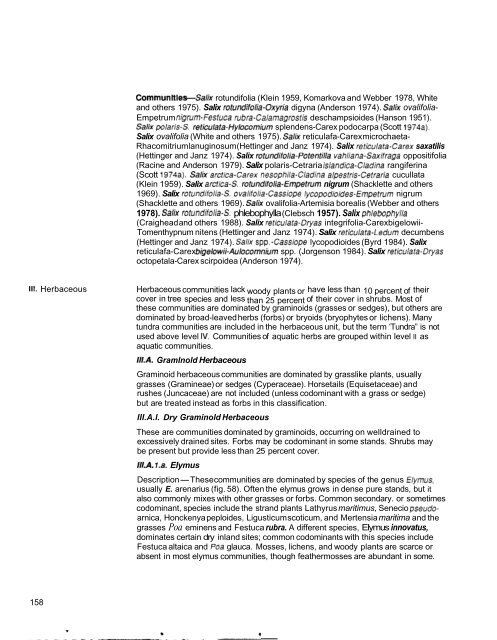The Alaska Vegetation Classification - Alaska Geobotany Center ...
The Alaska Vegetation Classification - Alaska Geobotany Center ...
The Alaska Vegetation Classification - Alaska Geobotany Center ...
You also want an ePaper? Increase the reach of your titles
YUMPU automatically turns print PDFs into web optimized ePapers that Google loves.
Communltles-Salk rotundifolia (Klein 1959, Komarkova and Webber 1978, Whiteand others 1975). Salix rotundifolia-Oxyria digyna (Anderson 1974). Salk ovalifolia-Empetrum nigrum-festuca rubra-Calamagrostis deschampsioides (Hanson 1951).Salk polaris-S. reticulata-Hylocomium splendens-Carex podocarpa (Scott 1974a).Salix ovalifolia (White and others 1975). Salk reticulafa-Carex microchaeta-Rhacomitrium lanuginosum (Hettinger and Janz 1974). Salix reticulata-Carex saxatilis(Hettinger and Janz 1974). Salix rotundifolia-Potentilla vahliana-Saxifraga oppositifolia(Racine and Anderson 1979). Salix polaris-Cetraria islandica-Cladina rangiferina(Scott 1974a). Salk arctica-Carex nesophila-Cladina alpestris-Cetraria cucullata(Klein 1959). Salix arctica-S. rotundifolia-Empetrum nigrum (Shacklette and others1969). Salix rotundifolia-S. ovalifolia-Cassiope lycopodioides-Empetrum nigrum(Shacklette and others 1969). Salk ovalifolia-Artemisia borealis (Webber and others1978). Salk rofundifolia-S. phlebophylla (Clebsch 1957). Salix phlebophylla(Craighead and others 1988). Salix reticulata-Dryas integrifolia-Carex bigelowii-Tomenthypnum nitens (Hettinger and Janz 1974). Salix reticulata-Ledum decumbens(Hettinger and Janz 1974). Salix spp.-Cassiope lycopodioides (Byrd 1984). Salixreticulafa-Carex bigelowii-Aulocomnium spp. (Jorgenson 1984). Salix reticulata-Dryasoctopetala-Carex scirpoidea (Anderson 1974).111. HerbaceousHerbaceous communities lack woody plants or have less than 10 percent of theircover in tree species and less than 25 percent of their cover in shrubs. Most ofthese communities are dominated by graminoids (grasses or sedges), but others aredominated by broad-leaved herbs (forbs) or bryoids (bryophytes or lichens). Manytundra communities are included in the herbaceous unit, but the term ‘Tundra” is notused above level IV. Communities of aquatic herbs are grouped within level II asaquatic communities.MA. Gramlnold HerbaceousGraminoid herbaceous communities are dominated by grasslike plants, usuallygrasses (Gramineae) or sedges (Cyperaceae). Horsetails (Equisetaceae) andrushes (Juncaceae) are not included (unless codominant with a grass or sedge)but are treated instead as forbs in this classification.III.A.l. Dry Graminold Herbaceous<strong>The</strong>se are communities dominated by graminoids, occurring on welldrained toexcessively drained sites. Forbs may be codominant in some stands. Shrubs maybe present but provide less than 25 percent cover.MA. 1.a. ElymusDescription-<strong>The</strong>se communities are dominated by species of the genus Nymus,usually E. arenarius (fig. 58). Often the elymus grows in dense pure stands, but italso commonly mixes with other grasses or forbs. Common secondary. or sometimescodominant, species include the strand plants Lathyrus maritimus, Senecio pseudoarnica,Honckenya peploides, Ligusticum scoticum, and Mertensia maritima and thegrasses Poa eminens and Festuca rubra. A different species, Elymus innovatus,dominates certain dry inland sites; common codominants with this species includeFestuca altaica and Poa glauca. Mosses, lichens, and woody plants are scarce orabsent in most elymus communities, though feathermosses are abundant in some.158
















